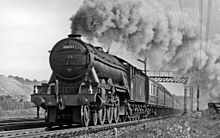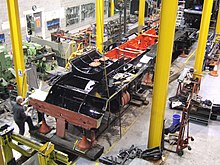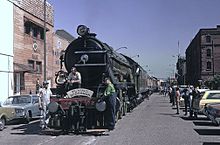LNER class A3
| LNER classes A1 and A3 | |
|---|---|
|
Class A3 " Flying Scotsman " locomotive in the same condition as around 1959 ( British Rail paint with number 60103, double chimney and Witte smoke deflectors )
|
|
| Numbering: | A1: 2543-2582, 4470-4481 A3: 2500-2508, 2595-2599, 2743-2752, 2795-2797 |
| Number: | 79 |
| Year of construction (s): | A1: 1922-1924 A3: 1928-1935 |
| Type : | 2'C1 'h3 |
| Length over buffers: | 21,600 mm |
| Service mass: | A1: 94.1 t A3: 97.8 t |
| Friction mass: | A1: 60.8 t A3: 67.2 t |
| Wheel set mass : | A1: 20.3 t A3: 22.4 t |
| Top speed: | 174 km / h (record) |
| Indexed performance : | approx. 1,655 kW |
| Driving wheel diameter: | 2,032 mm |
| Impeller diameter front: | 965 mm |
| Rear wheel diameter: | 1,118 mm |
| Cylinder diameter: | 483 mm |
| Piston stroke: | 660 mm |
| Boiler overpressure: | A1: 12.4 bar A3: 15.2 bar |
| Grate area: | 3.830 m² |
| Superheater area : | A1: 48.73 m² A3: 65.30 m² |
| Evaporation heating surface: | 249.80 m² |
| Tender: | Tender |
The Class A3 of the British London and North Eastern Railway (LNER) is an express train steam locomotive with the wheel arrangement 2'C1 '( Pacific ) and a three-cylinder engine . The first 52 locomotives were originally designated as Class A1 , but have gradually been converted into Class A3. The best-known locomotive of this series is the no. 4472 Flying Scotsman , which was the first British locomotive to officially overcome the “100 miles per hour limit” (161 km / h).
History of origin
The first British "Pacifics"
In 1908 the Great Western Railway built the first British locomotive with the "Pacific" axle arrangement, which was introduced in America in 1901, the No. 111 The Great Bear . This initially remained a one-off, it wasn't until 1922 that Sir Nigel Gresley designed a Pacific again for the Great Northern Railway. The locomotive, built in the Doncaster railway workshop , was numbered 1470 and named Great Northern . A little later, the No. 1471 Sir Frederick Banbury followed . The locomotives caused a sensation during the test runs; Among other things, No. 1471 covered a distance of 170 km in 122 minutes with a 620 t train, which corresponds to an average of 83.5 km / h. A top speed of 123 km / h was achieved.
Class A1
Based on successful tests, the A1 locomotive type turned out to be the better design than the A2 class built by Vincent Raven for the North Eastern Railway . Therefore, ten more copies of this type were ordered. When they were delivered, the Great Northern Railway and the North Eastern Railway had already merged into the London and North Eastern Railway. The 1470 and 1471 had been renumbered 4470 and 4471, and the new machines were given the numbers 4472 to 4481. By 1924 another 40 locomotives followed (no. 2543-2582).
The new A3 class

Between 1928 and 1935 another 27 locomotives were added, which were designated as class A3 (No. 2500–2508, 2595–2599, 2743–2752 and 2795–2797). Outwardly, these vehicles differed only minimally from class A1; However, according to the state of the art, they had a boiler pressure increased from 12.4 to 15.2 bar and a larger superheater . This also required a wider steam collecting box that no longer fully fitted into the smoke chamber , so that it had to be widened laterally with two attachments. Class A1 and A3 could be visually distinguished from one another on these lids.
Modifications of the A1 to the A3
The A3 had a more powerful and therefore heavier boiler than the A1 and thus a slightly higher axle load , which prevented it from being used on some routes . However, because they had a significantly higher output and also a lower water and coal consumption, it was decided to convert all A1 to A3. In most cases the conversion took place when the boiler had to be replaced anyway.
The conversion from A1 (now known as A10) to A3 was completed by the end of 1948; An exception was the first A1, No. 4470, which was converted into the A1 / 1 class in 1945, an optically not very successful conversion with an A4 boiler and rearward-moving external cylinders to provide an independent third Walschaerts control for the central cylinder to accommodate.
Names
As is customary in Great Britain, all locomotives were given proper names, which were also placed on signs on the locomotive. Except for five copies, all A1 and A3 were named after famous racehorses, which is why the names seem to have an unspecified origin. Two of the locomotives were renamed over time.
construction
The overall design of the A3 was of a common type as a single-frame steam locomotive with a 2'C1 'wheel arrangement. The boiler was equipped with a superheater for superheated steam operation, the wheel sets were driven by three steam cylinders , with the piston rod of the cylinder placed in the center under the front smoke chamber driving the first drive axle designed as a crankshaft . The outer cylinders worked on the second drive axis. A tender was brought along for the supply of fuel and water .
Weight distribution
Although the A3 looks rear-heavy from the outside, it was possible to keep the weight resting on the rear running axle (axle load) low and thus avoid a weak point of many Pacific locomotives, as also occurred, for example, with the German class 10 . Tests had shown that heavily loaded running axles put a lot of strain on the track because of their smaller diameter .
In order to shift the weight of the locomotive forward as much as possible, Gresley designed the boiler with a steeply inclined front transverse wall of the standing boiler, which extended to the center of the boiler and did not, as usual, end at the bottom of the long boiler. In the process, a combustion chamber was created in the lower half of the boiler , which shifted the heavy pipe wall and thus the boiler's center of gravity to the front.
Weight was also saved on the trailing axle itself by doing without a drawbar frame. The axle was mounted in an outer frame, with the special shape of the axle bearings not only allowing them to be moved laterally, but also moving around an ideal pivot point ( Cartazzi design ).
Three-cylinder engine
Like all three-cylinder locomotives from Sir Nigel Gresley, the A1 and A3 were equipped with his patented control , in which the movement of the slide of the inner cylinder is derived from the movements of the slide of the outer cylinder via a linkage in front of the cylinders, which in turn is derived from a normal Walschaerts (Heusinger) controls have been moved.
Gresley's design, which only required two simple levers, had the advantage that a poorly accessible third control linkage between the wheels could be dispensed with, as was used, for example, in the German standard locomotives of the 01.10 , 03.10 and 05 series. However, with increasing wear due to operational reasons, the bearing play became so large that it was no longer possible to supply all three cylinders with steam evenly, because the play-related inaccuracies of the two external controls and the transmission rod added up.
tender
The A1 and A3 were equipped with a four-axle tender . This had no bogies, but axles that were fixed in the frame. As is customary with the LNER, the tenders were equipped with a scoop device, with which feed water could be refilled from a trough between the rails while the journey was in progress . The tenders of five locomotives were provided with a narrow side aisle for changing personnel during the journey ( corridor tender ).
Conversion variants
From 1954 onwards, when a boiler swap was due, some A3 were given the somewhat more powerful LNER class A4 boilers . In 1957 and 1958, all A3s were equipped with a Kylchap blowpipe system, which one of the locomotives had received as a trial in 1937.
Because the chimneys of the A1 and A3 were very short due to the narrow British vehicle gauge, the view of the locomotive staff was obstructed by steam and smoke swirling along the boiler. It was not until 1960 that Witte smoke deflectors based on the German model were installed, which solved the problem.
Notable rides
Non-stop long distance journeys
The refueling device and the scarcely sufficient dimensioning of the coal supply made it possible to drive the 632 km long route between London and Edinburgh without stopping. However, because of the long journey, an intermediate stop was initially necessary to change personnel. To avoid this, the tenders of five locomotives were provided with a narrow side passage through which the personnel from the first car could transfer. The first scheduled non-stop trip on this route took place on May 1, 1928 and was a sensation at the time. The travel time on the route was 8 hours.
Speed records
The no. 4472 is still in its structural condition of the A1 Flying Scotsman went on 30 November 1934 as the first British locomotive officially 100 mph (161 km / h), a record that unofficially from since 1904 GWR 3700 Class City of Truro was held , a 2'B locomotive for the Great Western Railway. The 4472 was not rebuilt until 1947.
The A3 No. 2750 Papyrus drove even faster on March 5, 1935. On a long-distance test drive between Newcastle and London , it reached 174 km / h with a 220 t train and an average speed of 109 km / h over 431.7 km. This made it the fastest uncovered steam locomotive in Great Britain, as only the streamlined locomotives of the LNER class A4 and the Princess Coronation class of the London, Midland and Scottish Railway (LMS) were faster .
Even in normal operation, the locomotives regularly exceeded 90 mph (145 km / h).
Whereabouts
All 79 A3 locomotives survived the Second World War. The first locomotive was retired in 1959, the others followed between 1961 and 1966.
The only class A3 locomotive that has survived to this day is the No. 4472 Flying Scotsman , one of the most famous steam locomotives of all (see pictures). The locomotive, which was decommissioned in 1963 and had the number 60103 on British Railways , was bought by Alan Pegler and given its characteristic green LNER livery and its old number. She also received a second tender so that she could cover longer distances without taking water. In this form, numerous special trips were made with the locomotive, including in the USA and Australia, where it set another record in 1989: a distance of 422 miles (679 km) was covered in 9 hours and 25 minutes without stopping - the longest non-stop journey ever made with a steam locomotive.
Other private owners followed, but eventually the condition of the locomotive made it impossible to use it. After the owners could not raise the financial means for a restoration, the Flying Scotsman stood dismantled for a few years and with an uncertain fate in London. In 1996, Dr. Tony Marchington took the locomotive and it was extensively restored for £ 750,000. The Flying Scotsman has been operational again since 1999 , and in 2004 it was sold to the National Railway Museum in York . The locomotive continued to be used regularly on special trips, mostly on the York – Scarborough railway line . From 2006 it was completely renovated and completely dismantled. At the beginning of 2016 the Flying Scotsman was ready for use again, the first test drive took place on January 8, 2016 in Bury . On May 15, 2016, the locomotive was greeted by thousands of spectators on its first use in Scotland on journeys over the Borders Railway and the Forth Bridge .
literature
- Wilhelm Reuter: record locomotives . Motorbuch Verlag Stuttgart ISBN 3-87943-582-0
Web links
- English page with a list of all A1 and A3 locomotives
- Side of the National Railway Museum for Flying Scotsman (English)
Individual evidence
- ↑ a b "Flying Scotsman" is steaming again , SPIEGEL, January 8, 2016
- ↑ Thousands celebrate Flying Scotsman's return to Scotland , BBC report on the occasion of the restart of the “Flying Scotman” on May 15, 2016






